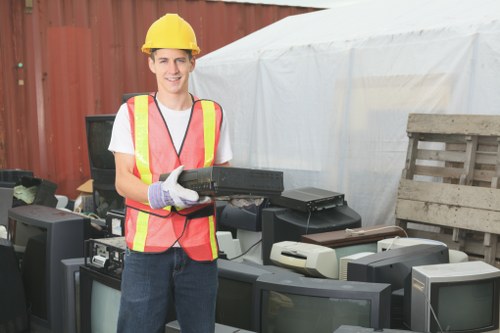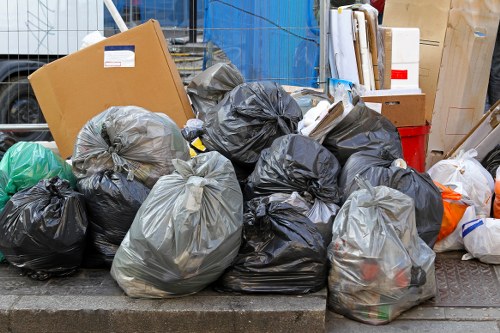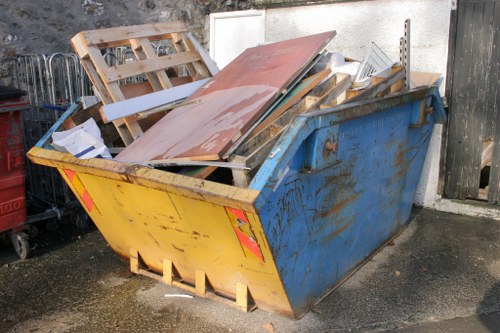Effective Waste Collection Strategies in Furniture Disposal

Introduction to Waste Collection in Furniture Disposal
In today's environmentally conscious society, the proper disposal of furniture has become increasingly important. Furniture disposal not only involves removing old or unwanted pieces but also ensuring that waste is managed responsibly to minimize environmental impact. Effective waste collection plays a crucial role in this process, enabling the recycling, repurposing, or safe disposal of materials.
Waste collection in furniture disposal encompasses various methods and strategies aimed at reducing landfill usage and promoting sustainable practices. From curbside pickup to specialized recycling centers, understanding the different waste collection options can help individuals and businesses make informed decisions about how to handle their discarded furniture.
Moreover, proper waste collection helps in conserving natural resources by facilitating the recovery of valuable materials. Metals, wood, and plastics from old furniture can be recycled and reused, reducing the need for virgin materials and lowering the overall environmental footprint.

Types of Furniture Waste Collection Methods
1. Curbside Pickup Services
Curbside pickup services offer a convenient way for residents to dispose of unwanted furniture. Typically provided by municipal waste management agencies or private companies, these services allow individuals to schedule a pickup time, during which their old furniture is collected directly from their property.
This method is particularly beneficial for large items that are not feasible to transport by regular trash collection. By offering scheduled pickups, curbside services ensure that furniture is collected systematically, reducing the chances of improper disposal.
However, the availability and frequency of curbside pickup services can vary depending on the location and the service provider. It's essential to check local regulations and guidelines to understand what items are accepted and any associated fees.

2. Recycling Centers
Recycling centers specialize in processing and repurposing materials from discarded furniture. These facilities dismantle furniture pieces to separate different materials, such as wood, metal, and plastics, which can then be recycled or reused in manufacturing new products.
By utilizing recycling centers, individuals and businesses can ensure that their old furniture contributes to a circular economy, where materials are continuously reused, minimizing waste and conserving resources.
Access to recycling centers may require transporting the furniture to the facility, which might involve additional logistics. However, the environmental benefits of recycling often outweigh the inconvenience of transportation.

3. Donation and Reuse Programs
Before opting for disposal, donating unwanted furniture can be a sustainable alternative. Many organizations accept gently used furniture, refurbish it if necessary, and provide it to those in need. This approach not only reduces waste but also supports community initiatives.
Donation centers and charities often have specific guidelines regarding the condition and types of furniture they accept. Ensuring that the items meet these requirements can increase the chances of successful donation and reuse.
Additionally, some regions offer incentives, such as tax deductions or pickup services, to encourage furniture donations. Taking advantage of these programs can make the process more efficient and rewarding.

4. Landfill Disposal
When other disposal methods are not feasible, landfill disposal remains an option. However, this method is the least environmentally friendly, as it contributes to the accumulation of waste and the potential release of harmful substances into the environment.
Landfill disposal should be considered a last resort after exploring recycling, donation, and other sustainable options. Properly managing waste through alternative methods can significantly reduce the environmental impact associated with furniture disposal.
Moreover, some municipalities may charge higher fees for landfill disposal to discourage its use and promote more sustainable waste management practices.
Benefits of Effective Waste Collection in Furniture Disposal
Implementing efficient waste collection methods for furniture disposal offers numerous benefits. These include environmental conservation, resource efficiency, and economic advantages.
Environmental Conservation: Proper waste collection reduces the number of furniture pieces ending up in landfills, decreasing greenhouse gas emissions and soil contamination. Recycling and repurposing materials help preserve natural resources and reduce the need for new raw materials.
Resource Efficiency: By recovering and reusing materials from old furniture, waste collection enhances resource efficiency. Metals, woods, and plastics can be reused in various industries, promoting a sustainable cycle of use and reuse.
Economic Advantages
Effective waste collection can lead to cost savings for both individuals and businesses. Recycling and donating furniture can be more economical than paying for landfill disposal or purchasing new items.
Furthermore, recycling centers and donation programs often create jobs and stimulate local economies by supporting industries related to waste management and material processing.
Investing in proper waste collection systems can also lead to long-term financial benefits by fostering sustainable practices that reduce overall waste management costs.
Regulatory Compliance
Adhering to local and national regulations regarding waste disposal is essential for individuals and businesses. Effective waste collection ensures compliance with legal requirements, avoiding potential fines and penalties associated with improper disposal practices.
Understanding and following regulations related to hazardous materials, recycling mandates, and disposal guidelines can help maintain environmental standards and promote responsible waste management.
Staying informed about evolving regulations ensures that waste collection strategies remain effective and legally compliant over time.
Challenges in Waste Collection for Furniture Disposal
Despite the benefits, waste collection in furniture disposal faces several challenges that can hinder its effectiveness. Addressing these obstacles is crucial for improving waste management practices.
Logistical Issues: Collecting large furniture items requires specialized transportation and handling. Ensuring that waste collection services have the necessary infrastructure and resources can be challenging, especially in densely populated or remote areas.
Cost Factors: The expenses associated with waste collection, including transportation, labor, and processing, can be significant. Balancing cost efficiency with effective waste management strategies is a common challenge for service providers and individuals alike.
Lack of Public Awareness
A lack of awareness about sustainable disposal options can result in improper waste practices. Educating the public about available waste collection methods, recycling programs, and the environmental impact of furniture disposal is essential for fostering responsible behaviors.
Effective communication and outreach initiatives can enhance public understanding and participation in sustainable waste collection practices.
Providing accessible information and resources encourages individuals to make informed decisions about furniture disposal, promoting overall waste management effectiveness.
Contamination and Sorting Issues
Contamination of recyclable materials with non-recyclable components can complicate waste processing efforts. Proper sorting and separation of materials are necessary to ensure that recycled materials meet quality standards and can be effectively reused.
Implementing efficient sorting systems and training personnel in proper waste handling techniques can mitigate contamination issues and improve the overall efficiency of waste collection processes.
Additionally, promoting consumer responsibility in separating materials before disposal can enhance the quality of collected waste streams.
Innovative Solutions for Waste Collection in Furniture Disposal
To overcome the challenges associated with waste collection in furniture disposal, innovative solutions and technologies are being developed and implemented. These advancements aim to enhance efficiency, reduce costs, and minimize environmental impact.
Smart Waste Collection Systems: Leveraging technology such as IoT sensors and data analytics can optimize waste collection routes, monitor collection status in real-time, and improve overall efficiency. Smart systems can reduce operational costs and enhance service reliability.
Automation and Robotics: The integration of automation and robotics in sorting and processing facilities can streamline operations, increase processing speeds, and reduce labor costs. Automated systems can also improve the accuracy and consistency of material sorting.
Material Recovery Facilities (MRFs)
MRFs play a pivotal role in enhancing waste collection for furniture disposal by providing specialized facilities for sorting and processing recyclable materials. These facilities employ advanced technologies to recover valuable resources from discarded furniture, facilitating their reuse in various industries.
By investing in MRFs, municipalities and businesses can improve their waste management capabilities, increase recycling rates, and promote sustainable practices within their communities.
MRFs also contribute to reducing the environmental footprint by ensuring that materials are efficiently recovered and reintegrated into the production cycle.
Extended Producer Responsibility (EPR)
EPR policies hold manufacturers accountable for the end-of-life management of their products, including furniture. By requiring producers to take responsibility for the disposal and recycling of their products, EPR encourages the design of more sustainable and recyclable furniture items.
This approach promotes a shift towards environmentally friendly manufacturing practices and ensures that waste collection systems are supported by the producers of the furniture.
Implementing EPR can lead to increased recycling rates, reduced waste generation, and the development of more sustainable product designs.
Best Practices for Effective Waste Collection in Furniture Disposal
Adopting best practices in waste collection can significantly enhance the efficiency and sustainability of furniture disposal efforts. These practices focus on optimizing processes, engaging stakeholders, and promoting environmental responsibility.
Comprehensive Planning: Developing a strategic waste collection plan is essential for ensuring that all aspects of furniture disposal are addressed. This includes identifying the most suitable collection methods, allocating resources effectively, and setting achievable goals.
Stakeholder Engagement: Collaborating with various stakeholders, including local governments, waste management companies, and community organizations, can facilitate the implementation of effective waste collection systems. Engaging stakeholders ensures that diverse perspectives are considered, leading to more holistic and effective solutions.
Public Education and Awareness
Raising awareness about the importance of proper furniture disposal and the available waste collection options is crucial for fostering responsible behaviors. Educational campaigns, workshops, and informational materials can empower individuals to make environmentally conscious decisions.
Providing clear instructions on how to prepare furniture for disposal, such as disassembling large items or separating recyclable components, can improve the efficiency of waste collection processes.
Encouraging community participation in waste management initiatives enhances the overall effectiveness and sustainability of furniture disposal efforts.
Sustainable Design and Manufacturing
Promoting sustainable design principles in furniture manufacturing can reduce the environmental impact associated with disposal. Designing furniture that is easier to disassemble, repair, and recycle facilitates more efficient waste collection and material recovery.
Manufacturers can incorporate renewable materials, minimize the use of hazardous substances, and design for longevity to enhance the sustainability of their products.
By prioritizing sustainability in design and manufacturing processes, the furniture industry can contribute to more effective and eco-friendly waste collection practices.
The Role of Technology in Enhancing Waste Collection
Technology plays a vital role in transforming waste collection systems for furniture disposal. From data-driven approaches to advanced machinery, technological innovations can significantly improve the efficiency and effectiveness of waste management processes.
Data Analytics: Utilizing data analytics can help waste management providers understand patterns in waste generation and collection. This information can be used to optimize collection schedules, allocate resources effectively, and predict future waste trends.
Mobile Applications: Mobile apps can facilitate easier scheduling of waste pickups, provide information on disposal guidelines, and offer tracking of waste collection status. These tools enhance user convenience and engagement, promoting more responsible disposal behaviors.
Advanced Sorting Technologies
Implementing advanced sorting technologies, such as optical sorting and magnetic separation, can improve the accuracy and efficiency of material recovery in waste collection. These technologies can quickly and accurately identify and separate different materials, enhancing the quality of recycled outputs.
Automated sorting systems reduce the reliance on manual labor, decrease processing times, and minimize the likelihood of contamination in recyclable materials.
Investing in advanced sorting technologies can lead to higher recycling rates and more efficient waste management systems.
Blockchain for Waste Tracking
Blockchain technology can be utilized to create transparent and secure records of waste collection and disposal activities. This ensures traceability and accountability throughout the waste management process, from collection to recycling or disposal.
By implementing blockchain solutions, waste management companies can enhance trust with stakeholders, reduce fraud, and ensure compliance with regulatory requirements.
Blockchain can also facilitate better coordination among different entities involved in waste collection, improving overall system efficiency.
Conclusion
Waste collection in furniture disposal is a critical component of sustainable waste management. By implementing effective waste collection strategies, individuals and businesses can contribute to environmental conservation, resource efficiency, and economic sustainability.
Understanding the various waste collection methods, overcoming associated challenges, and adopting innovative solutions are essential for enhancing the effectiveness of furniture disposal practices.
By prioritizing responsible waste management and embracing sustainable practices, we can ensure a healthier environment and a more sustainable future for all.
Contact us today to learn more about our waste collection services and how we can help you dispose of your furniture responsibly.